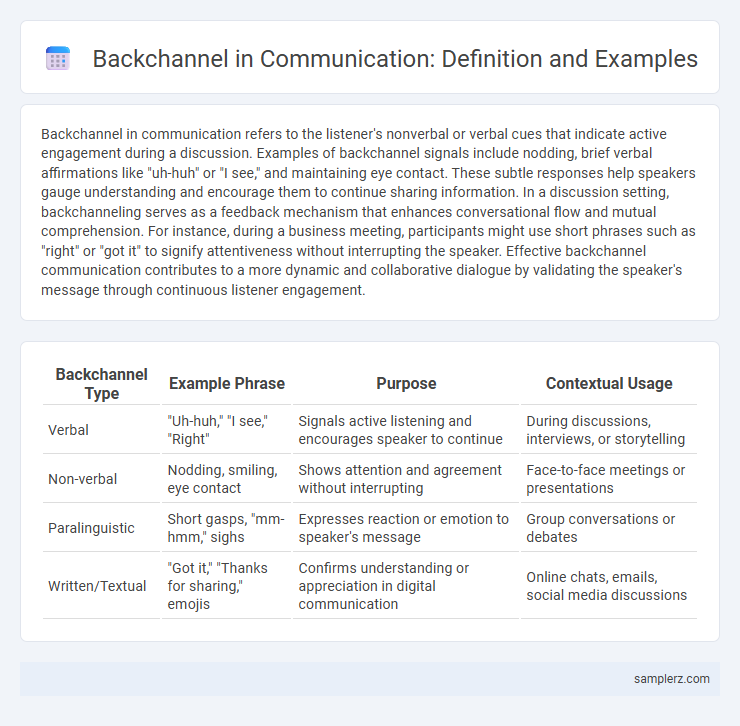Backchannel in communication refers to the listener's nonverbal or verbal cues that indicate active engagement during a discussion. Examples of backchannel signals include nodding, brief verbal affirmations like "uh-huh" or "I see," and maintaining eye contact. These subtle responses help speakers gauge understanding and encourage them to continue sharing information. In a discussion setting, backchanneling serves as a feedback mechanism that enhances conversational flow and mutual comprehension. For instance, during a business meeting, participants might use short phrases such as "right" or "got it" to signify attentiveness without interrupting the speaker. Effective backchannel communication contributes to a more dynamic and collaborative dialogue by validating the speaker's message through continuous listener engagement.
Table of Comparison
| Backchannel Type | Example Phrase | Purpose | Contextual Usage |
|---|---|---|---|
| Verbal | "Uh-huh," "I see," "Right" | Signals active listening and encourages speaker to continue | During discussions, interviews, or storytelling |
| Non-verbal | Nodding, smiling, eye contact | Shows attention and agreement without interrupting | Face-to-face meetings or presentations |
| Paralinguistic | Short gasps, "mm-hmm," sighs | Expresses reaction or emotion to speaker's message | Group conversations or debates |
| Written/Textual | "Got it," "Thanks for sharing," emojis | Confirms understanding or appreciation in digital communication | Online chats, emails, social media discussions |
Understanding Backchannel Communication in Discussions
Backchannel communication in discussions includes nonverbal cues like nodding, short verbal affirmations such as "mm-hmm" or "I see," and brief gestures that indicate active listening and understanding. These subtle signals help speakers gauge audience engagement and adjust their messaging accordingly, enhancing conversational flow and clarity. Recognizing and effectively employing backchannel responses fosters smoother interaction and deeper comprehension in communication settings.
Common Verbal Backchannel Cues: Examples and Usage
Common verbal backchannel cues such as "uh-huh," "I see," and "right" serve as brief signals to indicate attention and understanding without interrupting the speaker. These cues help maintain the flow of conversation by providing feedback that encourages the speaker to continue. Frequent usage of such backchannels enhances active listening in discussions across various communication settings.
Nonverbal Backchannel Signals: How They Influence Interaction
Nonverbal backchannel signals, such as nodding, eye contact, and facial expressions, play a crucial role in communication by signaling attentiveness and understanding during discussions. These subtle cues encourage the speaker to continue, reinforce engagement, and help maintain conversational flow. Effective use of nonverbal feedback enhances interpersonal connection and reduces misunderstandings in both personal and professional interactions.
Active Listening: Backchannel Responses That Show Engagement
Backchannel responses such as nodding, saying "uh-huh," or brief verbal affirmations like "I see" actively demonstrate engagement and understanding during a discussion. These subtle cues facilitate smooth communication by signaling attentiveness without interrupting the speaker. Effective use of backchanneling enhances conversational flow and strengthens interpersonal connections.
Backchannel in Virtual Meetings: Digital Examples
In virtual meetings, backchannel communication often occurs through chat functions where participants share real-time reactions, such as agreement, questions, or resources, without interrupting the speaker. Platforms like Zoom and Microsoft Teams facilitate backchanneling by enabling instant messaging alongside video calls, enhancing engagement and collaborative problem-solving. This digital backchannel supports non-verbal cues and maintains conversational flow, crucial for effective virtual communication.
Cultural Variations in Backchannel Communication
Backchannel communication varies significantly across cultures, with Japanese speakers often using frequent minimal responses like "hai" or "un" to signal active listening, while American speakers rely more on nodding or verbal cues such as "uh-huh" and "right." In contrast, some Scandinavian cultures might use less vocal backchanneling, emphasizing silence to indicate attentiveness and understanding rather than interruption. These cultural variations in backchanneling behaviors affect conversational flow and listener engagement, highlighting the importance of cultural competence in cross-cultural communication contexts.
Effective Backchanneling: Dos and Don’ts in Conversation
Effective backchanneling involves using verbal cues like "mm-hmm," "I see," and brief nods to signal active listening and encourage speaker elaboration without interrupting the flow. Avoid overusing fillers or interrupting, as these actions can disrupt the speaker's train of thought and reduce communication clarity. Mastering subtle, timely backchannel signals enhances mutual understanding and fosters a more engaging and respectful dialogue.
The Role of Backchannel in Group Discussions
Backchannel cues such as nodding, "mm-hmm," and brief verbal affirmations play a crucial role in group discussions by signaling active listening and encouraging speakers to continue. These subtle feedback mechanisms enhance mutual understanding and maintain conversational flow, preventing misunderstandings and promoting collaborative problem-solving. Real-time backchannel responses also help regulate turn-taking and foster an inclusive communication environment.
Challenges and Misinterpretations of Backchannel Cues
Backchannel cues such as nodding, "uh-huh," and brief verbal affirmations often lead to challenges and misinterpretations in discussions. Speakers may misread these signals as agreement or understanding when they merely indicate listening or encouragement, causing confusion. Cultural differences significantly affect the perception and use of backchanneling, complicating effective communication across diverse groups.
Enhancing Communication Skills with Backchannel Strategies
Backchannel communication, such as nodding, brief verbal affirmations like "uh-huh," or eye contact, plays a crucial role in enhancing communication skills by signaling active listening and encouraging speaker confidence. These subtle feedback mechanisms help maintain engagement and clarify understanding without interrupting the flow of conversation. Incorporating backchannel strategies fosters more dynamic and responsive discussions, improving overall communication effectiveness in both personal and professional settings.

example of backchannel in discussion Infographic
 samplerz.com
samplerz.com